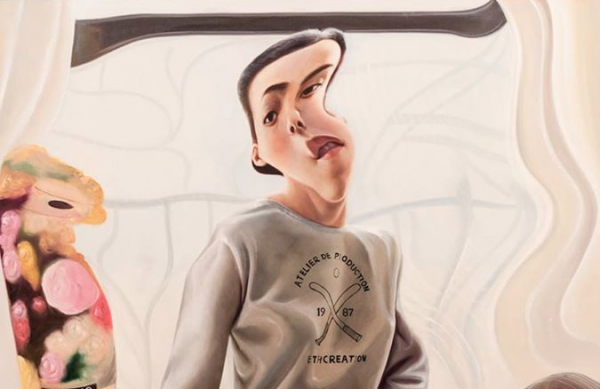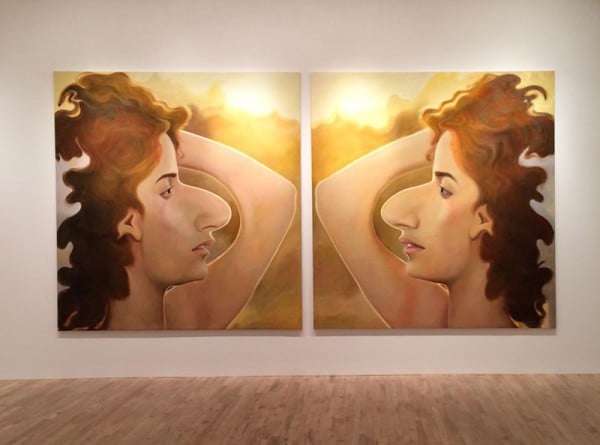Art & Exhibitions
Ryder Ripps Uses Jeff Koons Assistants for His Own Banality Series
Ripps's brand has always been defined by careless bravado.

Ripps's brand has always been defined by careless bravado.

Paddy Johnson

Prior to their launch, most shows are announced with a press release and a lead image. Ryder Ripps’s exhibition “Ho” at Postmasters (which runs through February 28th) came with a custom slideshow, a slew of negative pre-reviews and predictions, seemingly endless Ripps Facebook slagging and blog comment wars, mainstream magazine interviews, “Body Anxiety” (an online exhibition in response to the show—before the show even opened), and eventually an anonymous email attempting to blackmail the artist into cancelling his exhibition. And for what? In the end, it’s a show of “meh” paintings based on sportswear model Adrienne Ho’s Instagram account. They look like what Lisa Yuskavage might make if she had rudimentary Photoshop skills: 9 cartoon-like distortions of Ho’s image, painted by Jeff Koons’s assistants.
Probably, Ripps would have received a quarter of the attention he did for this show, were it not for his project Art Whore, launched this past November at the Ace Hotel. As part of his residency at the hotel, Ripps staged a protest against his own poor payment by hiring sensual masseuses on Craigslist, and inviting them to make drawings. The project earned Ripps headlines like In the Running For Most Offensive Project of 2014, and Artist’s Scummy Escort Exploitation Turns Art World Against Him, but it was his comments that threw fuel on the fire. “I choose sex workers because great art is like great sex” he quipped on Facebook. (On the day of the Charlie Hebdo tragedy, he also suggested on Twitter that his critics were akin to the radical terrorist group Al Qaeda. That tweet is now deleted.) Such glib remarks don’t align well with Ripps’s own identification as a conceptual artist.
That’s the Ripps brand, which has never been defined by thoughtfulness, but rather careless courage. And where this bravado has paid off in the past—his 2013 performance “Hypercurrentliving” sharply reflected on the speed and value of online life by pairing the consumption of energy beverage Red Bull with a marathon session of idea making and publishing—its success is less absolute in “Ho.”

Ryder Ripps, Nose Reflection (2014).
Photo: Paddy Johnson.
When entering the back room of Postmasters, the first massive diptychs a viewer sees apply a fun house-type distortion to mirror images of Ho drinking a beverage. By almost any definition, these types of images appeal to the eye; they employ the concept of multiples, mirrors, and female beauty. But their point doesn’t seem to be about creating a skilled painting as much as it does about producing a painted representation of online identity—one in which thousands of reflections of ourselves build likeness and ongoing narratives but also remain distortions of who we are. (Ripps says Ho is the perfect example of what he calls “corny-core”—marketing speak for staged, often nostalgic photography by amateurs who sometimes transition to pro.)
These concepts should be pretty self-evident to anyone who’s ever taken a selfie, so why this story needs to be told through the most obvious of painting gestures is a bit of a mystery. (At least with Richard Prince’s Instagram show at Gagosian (see Richard Prince Sucks), a viewer familiar with his methods of appropriation could piece together how it fit into his practice.) An ungenerous assessment sees the paintings and the use of Koons assistants as a cheap grab at the cultural capital afforded to artists in the gallery system. Naturally, Ripps has a different view. According to the artist, this question is answered through his interest in abstract expressionism. “Abstract passages referencing the heroic gestures of the Action Painters are generated through fingers moving across the decidedly unheroic touchscreen—the new site of aggression and anxiety in the age of the ‘virtual male gaze,’ where the archetypal macho painter has been emasculated.” Or, as Art F City’s Whitney Kimball paraphrased it recently on a Facebook thread, basically, “he’s expressing his suppressed manhood by using his fingers to smear a woman’s face.” You could argue what he’s doing is misogynistic, and it probably is, but the total absence of a defensible idea is the larger offense.
A simple look at the Gerhard Richter-type brushwork in the diptych, or any of the paintings, reveals that there’s not a single reference to the gestural paintings that created the archetypical macho painter, beyond, perhaps a nod to the billboard painting that influenced so many post-war artists. (Additionally, I have been deeply suspicious of the mythology of this male archetype for years). Ripps re-calibrated his message recently and told VICE the relationship between the work of Ab Ex artists and his own work was intuition, finally providing a gossamer-like thread connecting his work to the movement.
That lack of intellectual investment is a shame, because it leaves very little to talk about. One diptych pictures “Ho” with buck teeth in a red bikini, while another portrait shrinks her waist to the size of thimble. It’s a generic middle school boy iPad doodle fantasy on larger-than-life canvases.
That banality ultimately proves the death knell in this show. Unlike the best-known Pop artists of this century—Mike Kelley, Jeff Koons, and even early Richard Prince—Ripps isn’t much of an aesthete. Each of those artists had an ability to identify truly uncanny objects and photographs within American culture—the weird mounds of stuffed animals, balloon dogs, and pictures of cowboys endure today because something about those images sings. None of Ripps’s Instagram choices do that. The best painting we get is a mirror-image diptych of Ho, with Ripps’s nose grafted onto her face. If you can’t connect to someone more famous, superimpose yourself on her.
Mostly, though, there’s nothing there; Ho is just a pretty girl, and if she’s produced extraordinary poses, Ripps hasn’t identified them. Perhaps mediocrity is partly the point—mainstream commercial culture requires a lot of conventional packaging—but what significance could this possibly hold? With all the pre-existing banality out there, we certainly need a more discerning and critical eye than Ripps brings to his subjects.